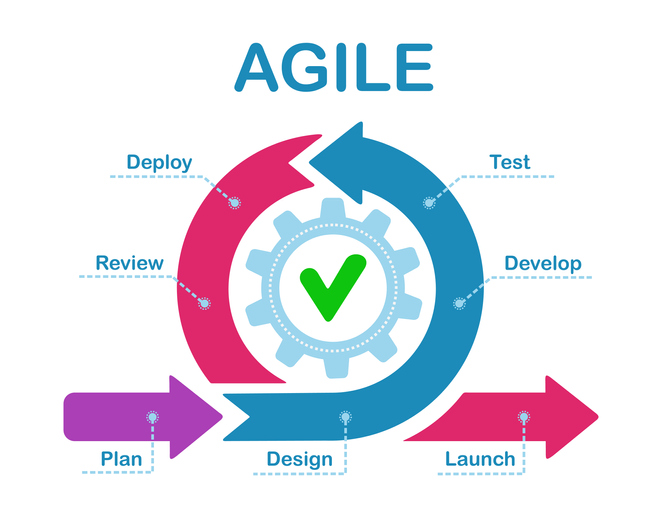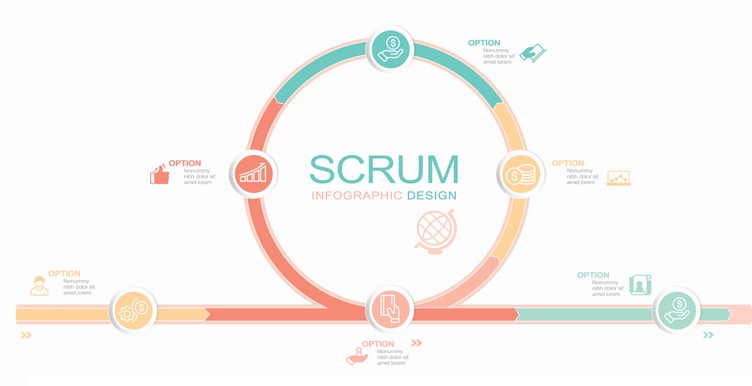Agile Vs Scrum – Fundamental Understanding and Differences
Agile is a set of principles for software development that emphasizes flexibility, collaboration, and customer value. Scrum is a specific framework within Agile that has a structured approach with defined roles, ceremonies, and artifacts. While Agile outlines the overarching philosophy and values, Scrum offers a concrete methodology to implement those principles in practice.
While comparing agile vs scrum, one must understand that Scrum is an Agile process framework in a very specific arrangement. Scrum and Kanban in software development are frameworks of Agile methodology with different arrangements. In short, if Agile is the fundamental principle, then Scrum is a specific type of those principles.When compared with other methodologies, Scrum has one advantage. In case, a feature in an iteration fails, it doesn’t impact other features. So, planning and execution of other features in an iteration continues and the end iteration can still be released.
Table of Contents
Agile vs. Scrum
| Aspect | Agile | Scrum |
|---|---|---|
| Definition | A set of principles for software development emphasizing flexibility and customer value. | A specific framework within Agile with a structured approach to project management. |
| Nature | Philosophical approach to software development. | Practical methodology with specific roles, ceremonies, and artifacts. |
| Scope | Broad umbrella term encompassing various methodologies. | One of the methodologies under the Agile umbrella. |
| Key Concepts | Continuous feedback, iterative development, collaboration. | Sprints, Product Owner, Scrum Master, Development Team, ceremonies, and artifacts. |
Best-suited Agile (Scrum, Kanban) courses for you
Learn Agile (Scrum, Kanban) with these high-rated online courses
What is Agile?
Agile is distinct from Scrum in terms of certain concepts and practices. These are segregated into 3 classes namely Roles, Artifacts, and Time Boxes. It contributes towards achieving organizational goals by enhancing the quality of deliverables, adapting to changes, offering better estimates through a reduced time span. Overall, it controls the project schedule in a better way. Agile progresses with every iteration comprising a team that serves towards a complete software development cycle. This cycle includes planning, requirements analysis, design, coding, unit testing, and acceptance testing at the time of the finished product’s demo.
Explore agile certification
Process of Agile
Agile is a set of principles for software development under which requirements and solutions evolve through the collaborative effort of cross-functional teams. Here’s a general step-by-step process:
1. Project Initiation:
- Define the project vision.
- Identify stakeholders and users.
- Create a product roadmap.
2. Product Backlog Creation:
- List all features, enhancements, and requirements for the product.
- Prioritize the backlog items based on business value and user needs.
3. Release Planning:
- Decide on a goal for the release.
- Select a set of backlog items that will achieve the release goal.
- Estimate the effort required for each item.
4. Iteration Planning:
- Choose a duration for the iteration (usually 1-4 weeks).
- Select backlog items for the iteration based on priority and estimated effort.
- Break down items into tasks and estimate effort for each task.
5. Iteration Execution:
- Develop, test, and integrate the product incrementally.
- Hold daily stand-up meetings to discuss progress and obstacles.
- Continuously integrate and test changes.
6. Iteration Review:
- Demonstrate the completed work to stakeholders.
- Gather feedback.
7. Iteration Retrospective:
- Reflect on the iteration.
- Identify areas of improvement.
8. Release:
- Once enough iterations are completed and the product is ready, release it to users.
9. Feedback and Maintenance:
- Gather feedback from users.
- Maintain and update the product based on feedback and changing requirements.
What is Scrum?
Scrum is one of the methodologies in Agile. It is a set of practices that should be implemented and adhered to keep the process in sync with the framework. It consists of a Sprint, which is a basic unit of development. Every Sprint commences with a planning meeting, wherein the relevant responsibilities are recognized and an assessment of obligations for that Sprint are outlined. It is followed by the conduct of reviews for reflective meetings to consider growth and establish accountabilities for the following Sprint. Each Sprint ends with a portion of the final product.
Process of Scrum
Scrum is a specific Agile framework with its own set of practices and roles. Here’s a step-by-step breakdown:
1. Product Backlog Creation:
- The Product Owner develops a prioritized list having features, enhancements, and fixes called the product backlog.
2. Sprint Planning:
- The team selects a set of highest-priority items from the product backlog.
- These items are broken down into tasks and estimated.
- A sprint goal is defined.
3. Sprint (usually 2-4 weeks):
- The Development Team works on the tasks.
- Daily Scrum (or stand-up) meetings are held to discuss progress and obstacles.
4. Sprint Review:
- In the end of sprint, the team will demonstrate completed work to Product Owner and stakeholders.
- Feedback is collected.
5. Sprint Retrospective:
- The team reflects on the sprint.
- They discuss what went well, what can be improved, and how to implement improvements in the next sprint.
6. Product Increment:
- The result of each sprint is a potentially shippable product increment.
7. Repeat:
- The process returns to Sprint Planning and repeats for the next set of backlog items.
8. Release:
- Once the product reaches a release-worthy state, it can be released to users.
FAQs
What is agile software development?
It is a group of iterative software development methodologies in which requirements and solutions evolve through collaboration among cross functional teams. The goal is to enhance the quality of the software and adapt to change in a faster way.
What is the Agile Manifesto?
Agile manifesto is a document that proposes a new way to develop software. The manifesto was proposed by 17 software developers in Snowbird, Utah. It has 12 key principles.
What are the key principles of the Agile Manifesto?
There are 12 key principles of the Agile manifesto 1. Ensuring early delivery of valuable software to the customer 2. Adapting to changes in requirement at any stage of development 3. Delivering working software from time to time 4. Developers and business should be coordinating throughout the project. 5. Work environment should be team friendly. 6. Face-to-face conversation should be given importance for effectively conveying the information. 7. Software should be working properly to ensure progress 8. For sustainable development, sponsors, developers and users should ensure consistent pace indefinitely 9. Technical excellence and good designs enhance agility 10. Keeping the process simple is important 11. Self-organizing teams are the basis of fulfilling requirements, creating premium quality designs and architectures. 12. Regular team meetings to ensure that everyone is on the same page. Read more on: https://agilemanifesto.org/principles.html
What is the difference between Agile and SDLC?
Both methodologies are used for the execution and management of projects. SDLC or Waterfall is sequential in nature which means another phase starts after the end of one phase. Due to this, the final product can only be delivered after the completion of all phases. Agile is iterative and therefore, an incremental workable product is available after iterations which usually last for a maximum period of 2 weeks. Agile is more flexible in comparison with SDLC.
What are the stages of the agile development life cycle?
There are six stages of the agile development life cycle to ensure predictable and manageable development of software. These include planning, analysis, design, implementation or development, testing or integration and maintenance.
What is Agile SDLC?
Agile SDLC model is the combination of both iterative and incremental process models with most of the focus on process adaptability and customers .
What is the difference between Kanban and Scrum?
No new items can be added to an ongoing iteration in scrum because it is schedule focused. However, in Kanban, new items can be added according to the available capacity.
Is scrum adaptive in nature?
Yes, it is adaptive in nature because it has a short sprint.
What is the role of a Scrum master?
The role of a scrum master is focused on product development on the system side. Scrum master resolves impediments and protects the team. The motive is to create a self sustaining and efficient team.
What are some useful tips for the Scrum Master to perform sprint retrospective meetings?
1. Scrum master should create a facilitation plan for every retrospective and ensure that the team is completing each step. 2. Ensure that any discussion during the retrospective should be strictly kept private to the team members. 3. Designate someone to be responsible for each item in order to ensure its implementation. 4. Review action items from previous retrospective. 5. Schedule the next retrospective.
What are the advantages and disadvantages of Scrum?
In terms of advantages, Scrum helps the team to expedite the completion of project deliverables. Any development can be coded and tested in the sprint review. Also, the team gains visibility on each actionable item. Overall, the workflow becomes streamlined. There are some disadvantages as well. First, it leads to scope creep due to the lack of an end date. There is a higher probability for negative impact on the project in case anyone leaves the team. Overall, scrum is successful in the presence of experienced and diligent team members.

Jaya is a writer with an experience of over 5 years in content creation and marketing. Her writing style is versatile since she likes to write as per the requirement of the domain. She has worked on Technology, Fina... Read Full Bio




